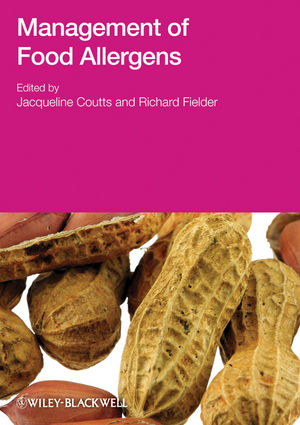Management of Food AllergensISBN: 978-1-4051-6758-1
Hardcover
272 pages
September 2009, Wiley-Blackwell
 |
||||||
Preface.
PART I: RISK ASSESSMENT.
1 The reality of food allergy: the patients’ perspective (David Reading).
1.1 Background.
1.2 Consumer reaction.
1.3 Supporting consumers.
1.4 Allergy services.
1.5 Teenagers and young adults.
1.6 Food labelling.
1.7 Allergen thresholds.
1.8 Food alerts.
1.9 Our work with industry.
1.10 The work of the FSA.
1.11 Schools.
1.12 Eating out.
1.13 Daily life with a food allergy.
1.14 Hopes for the future.
References.
2 Clinical incidence of food allergy (Zsolt Szépfalusi and Thomas Eiwegger).
2.1 Introduction.
2.2 Case 1 – Severe anaphylaxis to an unknown food product.
2.3 Case 2 – Idiopathic anaphylaxis.
2.4 Case 3 – Cross-reactivity or contamination?
2.5 Case 4 – To vaccinate or not in egg allergy.
2.6 Case 5 – Adrenalin auto-injector for all egg-allergic patients?
2.7 Case 6 – Immunotherapy for oral allergy syndrome?
2.8 Conclusion.
References.
3 Identification and characterisation of food allergens (E.N. Clare Mills, Philip Johnson, Yuri Alexeev, and Heimo Breiteneder).
3.1 Introduction.
3.2 Classification of food allergens.
3.3 Plant food allergens.
3.4 Animal food allergens.
3.5 Conclusions.
References.
4 Coeliac disease: allergy or intolerance? (Norma McGough).
4.1 Introduction.
4.2 About coeliac disease.
4.3 Prevalence and diagnosis.
4.4 What is gluten?
4.5 The gluten-free diet.
4.6 Gluten-free foods.
4.7 Prescriptions.
4.8 Allergen labelling.
4.9 Food production.
4.10 The Codex standard.
4.11 Gluten testing.
4.12 Gluten-free catering.
4.13 Cross-contamination.
4.14 Nutritional adequacy.
4.15 Lactose intolerance.
4.16 Coeliac UK.
References.
PART II: RISK MANAGEMENT.
5 Risk management – the principles (René Crevel).
5.1 Introduction.
5.2 Allergen management: the issues.
5.3 Development of allergen management plans: principles and considerations.
5.4 Objectives.
5.5 Application.
5.6 Concluding remarks.
References.
6 Risk management – operational implications (Anton J. Alldrick).
6.1 Introduction.
6.2 Identifying the hazard.
6.3 Managing the hazard.
6.4 Conclusion.
References.
7 Choices for cleaning and cross-contact (Steve Bagshaw).
7.1 Allergen management and cleaning.
7.2 The cleaning process.
7.3 Principles of cleaning.
7.4 Open plant cleaning.
7.5 Dry cleaning.
7.6 Manual cleaning.
7.7 Foam and gel cleaning.
7.8 Cross-contamination.
7.9 Floor cleaning.
7.10 Tray and rack washing machines.
7.11 Cleaning-in-place.
7.12 Management of allergen cross-contamination.
7.13 Cleaning management.
7.14 The cleaning programme.
References.
8 Validation of cleaning and cross-contact (Helen M. Brown).
8.1 Introduction.
8.2 Validation of a cleaning regime.
8.3 Sampling to validate cleaning.
8.4 What to measure to validate cleaning.
8.5 Summary.
References.
9 Validation, standardisation and harmonisation of allergen activities in Europe and worldwide (Bert Popping).
9.1 Analytical methods.
9.2 Method validation.
9.3 Standardisation of methods.
9.4 Harmonisation.
References.
10 Standardisation of analytical methodology with special reference to gluten analysis (Ingrid Malmheden Yman).
10.1 Introduction.
10.2 Methods and standards.
10.3 Gluten analysis.
10.4 Gluten determination.
11 Analytical choices (Marie-Claude Robert).
11.1 Development of allergen testing.
11.2 Test formats.
11.3 Commercial test kits.
11.4 Analytical issues specific to immunoassays.
11.5 Conclusions.
References.
12 Food allergen method development programme at Health Canada: support to standard setting and consumer protection (Samuel Benrejeb Godefroy, Michael Abbott, Terry Koerner, Dorcas Weber, and Theresa Paolisini).
12.1 Rationale to ACT on preventing food allergy incidents in Canada.
12.2 Health Canada’s food allergen methodology programme.
12.3 Conclusion.
References.
PART III: RISK COMMUNICATION.
13 Finished product labelling and legislation (Sue Hattersley).
13.1 Introduction.
13.2 Legislation on allergen labelling – European Directive 2003/89/EC and subsequent amendments.
13.3 Allergen cross-contamination and advisory labelling (such as ‘May Contain’ statements).
13.4 Provision of allergy information for foods that are not pre-packed.
13.5 ‘Free from’ foods.
13.6 Conclusions.
References.
14 Guidelines for manufacturing and certification programmes (Neil Griffiths).
14.1 Preface.
14.2 Introduction.
14.3 The law.
14.4 Voluntary information.
14.5 Guidelines.
14.6 Certification schemes.
14.7 Training.
14.8 The use of risk assessment.
14.9 Management.
14.10 The environment.
14.11 Labelling and communication.
14.12 Thresholds.
14.13 Testing.
14.14 Conclusions.
References.
15 Risk communication – a manufacturer’s perspective (Clive Beecham).
15.1 Background.
15.2 The process of going ‘nut free’.
15.3 The factory changes.
15.4 People disciplines.
15.5 Verification.
15.6 Retailer reaction.
15.7 What is nut free? – the problem of evolving science.
15.8 The need for thresholds.
Appendix: Useful web links.
Index.



